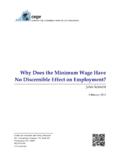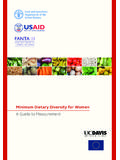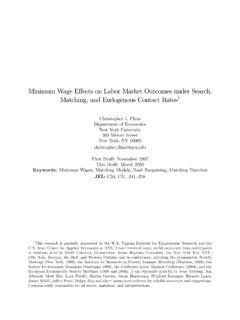Transcription of 071-2009: Choosing the Right Technique to Merge …
1 SAS Global Forum 2009 Coders' Corner Paper 071- 2009 . Choosing the Right Technique to Merge Large data Sets Efficiently Qingfeng Liang, Community Care Behavioral Health Organization, Pittsburgh, PA. ABSTRACT. Merging two data sets horizontally is a routine data manipulation task that SAS programmers perform almost daily. CPU time, I/O, and memory usage are factors that SAS programmers need to consider before data sets with large volumes are merged. This paper outlines different SAS merging techniques for both a many-to-one match, and a many-to-many match. For a many-to-one match, Merge , PROC SQL JOIN, FORMAT, ARRAY, and the HASH object were investigated, and their performances were benchmarked. For a many-to-many match, PROC SQL join and MATCH-CROSSING methods were discussed, and their performances were compared. This paper shows that the HASH object is the best choice to perform a many-to-one match no matter single value or multiple values are retrieved from lookup table.
2 ARRAY and FORMAT are also good choices with some restrictions. PROC SQL JOIN is the best choice for a many-to-many match. INTRODUCTION. The volumes of data SAS programmers deal with today are getting larger than several years ago, especially in health insurance area. When these large data sets are required to Merge together, it adds significant complications to data manipulation process. Therefore, performing efficient merging becomes very critical, especially with an implementation of data warehouse. Merging data sets is to combine two or more data sets horizontally by matching the keys from both data sets. This process is also referred as performing a table lookup, one data set serves as base table and the other is the lookup table. The records from the base table are matched to the records on a lookup table based on the common keys in both tables. There are four types of match merges: one-to-one match Merge , one-to-many match Merge , many-to- one match Merge and many-to-many match Merge .
3 The simplest case of a Merge is a one-on-one match Merge which for both the base table and lookup table each has the same unique identifier and the records are matched from both tables based on BY values of unique identifier. Many-to-one match Merge is defined as records in a base table with duplicate BY values are matched to the unique BY values in lookup table. For example, if we want to look at utilization of members' outpatient service by demographic information, we need to Merge outpatient services claims which a member could have multiple services during measurement period with member demographic information which each member is unique. One-to- many match Merge is the same as many-to-one match Merge if you treat the table with a unique key as lookup table rather than base table. Many-to-many match Merge refers to the BY value is not unique for both base table and lookup table.
4 Many-to-many match could be problematic but it is very useful, especially in healthcare area. Whether insurance claims are eligible to be paid, claims have to be merged with an enrollment table using member ID as the key to see whether the service happened within the eligible coverage period. There are times when the member ID is not unique in both tables. A member could have more than one claim during a certain time period and he/she can also have more than one enrollment record in enrollment file. In this case, many-to-many match is very helpful and handy. MANY-TO-ONE MATCH Merge . One-to-one match, one-to-many match and many-to-one match are dense matches and can be applied to the same merging Technique . In this paper, many-to-one match Merge will use to demonstrate different techniques and all the 1. SAS Global Forum 2009 Coders' Corner rows from base table will be in the final combined data set and some rows from the look up table may not appear in the final table if they didn't match any rows from the base table.
5 Table 1 and Table 2 show the layouts of the data sets which are used for benchmarking merging techniques. Table 1. Claims has 9,654,283 rows with duplicate BY values (ID) and the file size is about 230 MB. Table 2. Enrollment_nodup has 333,803 rows with unique BY value (ID) and the file size is about 13 MB. Table 1: Claims ID Start End Service Code Provider M10000001 2/1/2008 2/3/2008 H0001 P1000002. M10000001 1/13/2008 1/19/2008 H0002 P1000003. M10000001 1/1/2008 1/3/2008 H1010 P1000004. M10000001 4/13/2008 4/19/2008 T2000 P1000002. M10000008 1/1/2008 1/3/2008 H0001 P1000003. M10000005 2/13/2008 3/19/2008 H0002 P1000004. M10000005 1/1/2008 1/3/2008 H1010 P1000003. M10000009 2/10/2008 2/19/2008 T2000 P1000004.. Table 2: Enrollment_nodup ID Group_ID. M10000001 ABC. M10000002 BCD. M10000003 CDE. M10000004 DEF.. The final combined table has 9,654,283 records. All many-to-one match Merge techniques demonstrated in the paper will generate exactly the same result for the final combined table.
6 CPU time, Input\Output operation and memory usage are used to measure the performance. MANY-TO-ONE MATCH Merge TECHNIQUES. 1. PROC SQL JOIN. /* Left join will be used to take all records from the base table*/. proc sql noprint;. create table sql_merge as select a.*, from claims a left join enrollment_nodup b on ;. quit;. Codes are ANSI standard SQL syntax and easy to follow, but it can not be used in data step. Both data sets do not have to be sorted before join. Multiple values can be retrieved from lookup table. 2. Merge . /* Sort base table and lookup table BY ID first */. proc sort data = enrollment_nodup;. by id;. run;. proc sort data =claims;. by id;. run;. 2. SAS Global Forum 2009 Coders' Corner data match_merge;. Merge claims(in=a) enrollment;. by id;. if a;. run;. Both base table and lookup table have to be sorted by BY values before they can be combined. Codes are straight forward.
7 Multiple values can be returned from lookup table. 3. ARRAY. /* Find the range for ID in order to define Array */. proc sql;. select min(id) into: min_id from enrollment;. select max(id) into: max_id from enrollment;. quit;. data array_merge;. keep id group_id;. /* Load lookup table into Array */. if _N_=1 then do i=1 to numobs;. set enrollment nobs=numobs;. array groups{&min_id : &max_id} $ 25 _temporary_;. groups{id}=group_id;. end;. set claims;. group_id=groups{id};. run;. Codes are getting complex for merging using array in data step. First, the elements of array need to be determined using macro before the array is defined. Second, the lookup table has to be loaded into the array using DO loop. Third, the numeric key from base table is required to match the element from the array. data sets can be unsorted when the array is applied to combine data sets. But the array can only be used in data step and only one value can be returned from lookup table.
8 If more than one values are required from lookup table, multiple arrays have to be defined. Array can only store either numeric data items or character data items. 4. FORMAT. /* create temporary data to load into FORMAT */. data temp_fmt;. retain fmtname "groupfmt";. set enrollment(keep=id group_id rename=(id=start group_id=label));. run;. proc format library=work cntlin=temp_fmt;. run;. data format_merge;. set claims;. group_id=put(id, groupfmt.);. run;. First, the lookup table needs to be loaded in FORMAT and it could occupy a lot of resources if the number of records from the lookup table is huge. Second, the key in base table will be assigned to the created format using PUT. statement. The data sets do not have to be sorted and FORMAT can be used in procedures. Codes are not difficult but you do need to know how to load a data set into FORMAT. FORMAT can only store one data item per key.
9 Multiple formats need to be defined if more than one value will be retrieved from the lookup table. If that is the case, FORMAT is not an efficient way to do Merge . 5. HASH OBJECT. 3. SAS Global Forum 2009 Coders' Corner data hash_merge(drop=pp);. declare Hash group (dataset: "enrollment_nodup");. pp= ('id');. pp= ('group_id');. pp= ();. do until(eof1);. set enrollment_nodup end=eof1;. pp= ();. end;. do until(eof2);. set claims end=eof2;. call missing(group_id);. pp= ();. if pp =0 then output;. end;. run;. First, a HASH OBJECT is defined and named group and it is referred to data set enrollment_nodup . Second, id . is specified as the key of the HASH OBJECT and group_id is defined as data element. Third, the lookup table enrollment_nodup will be loaded into Hash object. Fourth, group_id is assigned to missing initially and the FIND. method uses the value of the key (ID) from base to determine if there is a match to the key in Hash object.
10 If a match is found, the data from two tables haven been combined and outputted to the data set hash_merge . HASH OBJECT can be used only in data step and data sets do not have to be sorted. HASH OBJECT offers some of advantages and flexibilities to Merge data sets. HASH OBJECT can use character variable, numeric variable, or a combination of variables as the key, and can store both multiple character variables and multiple numeric variables per key. PERFORMANCE COMPARISON. CPU time, I/O operation and Memory usage were used to benchmark performance. CPU time is the amount of time the Central Processing Unit uses to perform merging task, and includes user CPU time and system CPU time. I/O. operation measures the read and the write operations performed as data from storage to memory or from memory to storage. It measures the difference between real time and CPU time. Memory usage is the size of the work area required to hold data , buffers, etc.

















